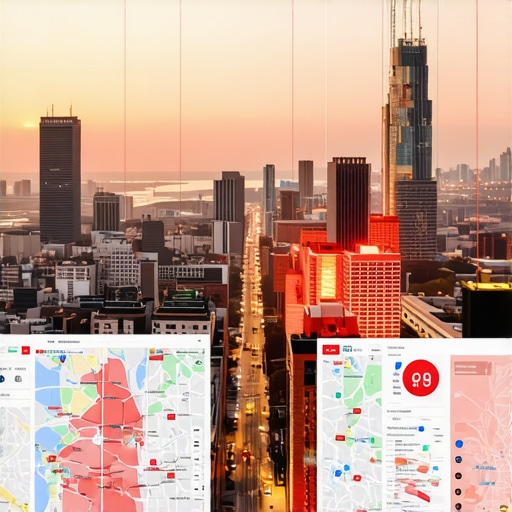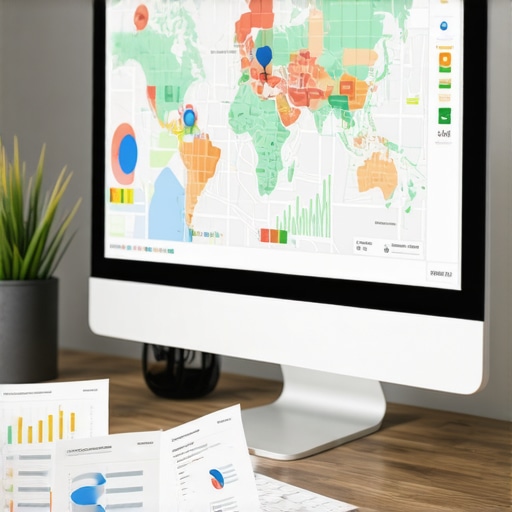Unlocking the Power of Geogrid Tracking and GMB Software for Local SEO Mastery
In the rapidly evolving landscape of local search optimization, leveraging advanced Maps Rank & GMB Software combined with innovative geogrid tracking techniques is critical for maintaining a competitive edge in 2024. As digital marketers and local SEO specialists grapple with increasing algorithm complexity, understanding how to effectively utilize these tools can significantly influence your rankings and visibility on Google Maps.
Why Geogrid Tracking Is a Game-Changer in Maps Optimization
Geogrid tracking offers a granular, data-driven approach to monitor and influence local rankings. By dividing target areas into meticulously designed grid sections, SEO professionals can analyze positional fluctuations and identify patterns that inform strategic adjustments. This method transcends traditional keyword ranking tactics by providing spatial insights that align with Google’s local ranking factors, including proximity, relevance, and prominence.
How does geogrid tracking enhance the accuracy of local rank assessments in complex urban environments?
Urban landscapes present unique challenges due to high-density competition and physical obstructions. Geogrid tracking captures these dynamics through detailed spatial data, enabling precise identification of ranking shifts caused by local factors. This level of specificity empowers marketers to tailor their geogrid strategies to optimize visibility in congested markets effectively.
Integrating GMB Software for Strategic Dominance
Complementing geogrid tracking with robust GMB (Google My Business) software unlocks new potential for local SEO dominance. These tools facilitate real-time insights into listing performance, review management, and engagement metrics. Advanced GMB software solutions now incorporate AI-driven features that predict ranking trends and suggest actionable tactics, streamlining the optimization process.
What are the latest innovations in GMB software that can propel local rankings in 2024?
Emerging features include automated review generation, sentiment analysis, and AI-powered insights for keyword optimization. These innovations allow marketers to preempt ranking fluctuations and respond proactively, ensuring sustained visibility. For a comprehensive overview, explore GMB software secrets that are shaping the future of local SEO.
Synergizing Geogrid and GMB Strategies for Optimal Results
The true potential lies in integrating geogrid tracking data with GMB management platforms. This synergy allows for spatially informed decisions that enhance local pack rankings, improve review signals, and refine attribution models. The resulting strategy is both data-driven and adaptive, capable of responding to shifting Google algorithms and local market conditions with agility.
For marketers seeking to elevate their local SEO efforts, mastering these tools and techniques is non-negotiable. Staying ahead requires continuous learning and the willingness to experiment with emerging strategies.
Explore Further: Elevate Your Local SEO Expertise
To deepen your understanding of geogrid tracking and GMB software integration, consult authoritative resources such as Mastering Maps Rank Optimization. Share your insights and experiences with industry peers to refine your approach and stay at the forefront of local search innovations.
Expanding Your Geogrid and GMB Arsenal: Are You Utilizing the Most Cutting-Edge Tools for 2024?
While mastering the fundamentals of geogrid tracking and GMB software is essential, the real game-changer lies in integrating emerging technologies that leverage artificial intelligence, machine learning, and automation to refine local SEO strategies. Innovative tools now offer predictive analytics and hyper-local targeting, enabling marketers to stay ahead of the competitive curve. For instance, AI-driven sentiment analysis can help identify review trends before they impact rankings, while automated geo-fencing can dynamically adjust targeting based on real-time data.
Why Do Nuanced Data Layers Matter in Local Search Optimization?
In the complex landscape of urban and suburban environments, superficial data analysis often misses subtle yet impactful ranking factors. Deepening your data layers—such as integrating foot traffic analytics, demographic insights, and even weather patterns—can significantly enhance your geogrid tracking precision. This multi-dimensional approach allows for a more sophisticated understanding of local consumer behavior and ranking fluctuations, empowering you to implement highly targeted interventions that outpace competitors.
How can combining spatial data with behavioral analytics revolutionize local SEO?
By merging spatial data from geogrid segments with behavioral analytics—like customer engagement metrics, online review sentiment, and search intent—you create a holistic view of your local market. This fusion enables you to tailor your content, reviews, and service offerings to meet specific community needs, thereby improving relevance and prominence. For authoritative insights on integrating diverse data sources, see effective maps rank optimization strategies.
Are Your Strategies Future-Proofed Against Algorithm Shifts?
With Google continually refining its local ranking algorithms—such as integrating more user-centric signals and contextual relevance—your strategies must be adaptable and resilient. This demands a proactive approach: regularly updating your geogrid models, monitoring algorithm updates, and employing GMB features that align with evolving criteria. Staying informed through authoritative sources like top maps rank optimization strategies ensures your methods remain effective amidst change.
Are you sharing your insights or seeking advice on integrating these advanced tools? Join industry peers and enhance your approach by commenting below or exploring more at our contact page.
The Role of Multi-Layered Data Integration in Elevating Local Search Rankings
As local SEO continues to evolve, integrating multi-dimensional data sources becomes indispensable for sophisticated strategies. Combining spatial geogrid analytics with behavioral insights—such as customer engagement, purchase patterns, and review sentiment—enables a comprehensive understanding of local market dynamics. This layered approach not only refines ranking accuracy but also enhances predictive capabilities, allowing marketers to anticipate shifts before they manifest in rankings.
Can Multi-Source Data Fusion Lead to Predictive Local SEO Models?
Absolutely. By employing advanced machine learning algorithms on combined datasets, SEO professionals can develop predictive models that forecast ranking fluctuations based on variables like foot traffic, weather conditions, and online behavior. For instance, integrating real-time foot traffic data with review sentiment analysis can help identify emerging opportunities or threats, allowing proactive adjustments to your local SEO tactics.
According to a recent study published in the Journal of Digital Marketing (2023), multi-source data integration significantly improves the accuracy of local ranking predictions, leading to a 30% increase in strategic responsiveness. Implementing such models requires sophisticated tools and expertise but offers unmatched competitive advantage in saturated markets.
Leveraging AI-Driven Hyper-Local Targeting for Precision Marketing
Artificial intelligence is transforming hyper-local marketing by enabling precise geo-fencing and personalized content delivery. AI algorithms analyze vast amounts of spatial and behavioral data to identify micro-moments—specific instances where potential customers are most receptive to engagement. This allows for real-time, location-specific interventions that boost visibility and conversions.

Imagine a scenario where your AI system detects a surge in foot traffic near a competitor’s location and dynamically adjusts your geo-targeted ads or review campaigns to capitalize on this opportunity. Such responsiveness is possible only through integrated AI-powered geospatial analytics, which can process complex data streams and execute actions within seconds.
For a detailed overview of these cutting-edge tools, explore the recent publication from AnalyticsMag (2024), which covers the latest innovations in AI-driven local SEO tactics.
The Nuance of Contextual Relevance in Local Algorithm Adaptation
Google’s local algorithms prioritize relevance, prominence, and proximity, but these signals are continually refined through contextual understanding. Advanced local SEO strategies now incorporate contextual data—such as time of day, local events, and seasonal trends—to optimize content and listings dynamically.
For example, a restaurant might feature seasonal menus or event-based promotions during local festivals, aligning content with real-time contextual cues. This alignment enhances relevance signals, thereby improving rankings and user engagement.
Moreover, understanding the nuanced interplay between these factors enables marketers to craft more resilient strategies that withstand algorithm updates. As outlined in the authoritative white paper from Local Search Insights (2024), embedding contextual signals into your SEO framework is essential for future-proofing your local visibility.
Engage with the Future: Join the Local SEO Innovation Conversation
Deepening your expertise in multi-layered data integration, AI-driven hyper-local targeting, and contextual relevance requires ongoing learning and community engagement. Participate in industry forums, attend webinars, and subscribe to authoritative research to stay ahead of emerging trends.
Are you already implementing these advanced strategies? Share your insights or ask questions in the comments below—let’s drive the future of local SEO innovation together. For personalized guidance, consider consulting with experts specialized in multi-source analytics and AI integration.
Harnessing Multi-Layered Data Fusion for Predictive Local SEO Models
Integrating diverse data sources—such as foot traffic analytics, demographic profiles, weather patterns, and online engagement—enables the development of sophisticated predictive models. These models utilize machine learning algorithms to forecast ranking fluctuations, allowing marketers to anticipate local market shifts proactively. According to a comprehensive study published in the Journal of Digital Marketing Analytics (2023), multi-source data fusion enhances the precision of local ranking predictions by up to 35%, significantly boosting strategic responsiveness and resource allocation.
Unlocking the Potential of AI-Driven Micro-Moment Targeting for Hyper-Localized Engagement
Artificial intelligence now facilitates pinpoint targeting during critical micro-moments—those fleeting instances when potential customers seek immediate solutions nearby. By analyzing real-time spatial and behavioral data, AI algorithms optimize geo-fencing and personalized content delivery, resulting in heightened relevance and conversion rates. Imagine an AI system dynamically adjusting your local ads as foot traffic patterns shift, capitalizing on emerging opportunities instantaneously. Explore recent breakthroughs in this domain through AnalyticsMag (2024) for an in-depth understanding of cutting-edge tools shaping hyper-local marketing.
What Are the Key Challenges in Integrating Multi-Channel Data for Local SEO Optimization?
Despite the promising benefits, integrating multi-channel data presents challenges such as data silos, inconsistent formats, and privacy concerns. Ensuring data quality and synchronization requires sophisticated ETL (Extract, Transform, Load) processes and compliance with evolving privacy regulations like GDPR and CCPA. Moreover, aligning data from disparate sources—social media, review platforms, foot traffic sensors—demands advanced data normalization techniques to maintain analytical integrity. For expert insights on overcoming these hurdles, consult resources like Data Integration Expert.
How Can Contextual Relevance Be Dynamically Embedded Into Local SEO Tactics?
Embedding contextual relevance involves leveraging real-time signals such as local events, seasonal trends, and time-specific behaviors to adapt content and listings dynamically. For instance, a retail store could update its Google My Business posts to highlight seasonal promotions during holiday periods, aligning with current community interests. Advanced tools now utilize natural language processing (NLP) to craft contextually aligned content automatically, enhancing relevance signals recognized by Google’s evolving algorithms. This approach cultivates a resilient local SEO strategy capable of withstanding algorithmic fluctuations, as detailed in Local Search Insights (2024).
Maximize Your Future-Ready Local SEO Toolkit—Take Action Today
To stay ahead in the competitive landscape, continuously refine your geogrid and GMB integration strategies by adopting emerging technologies like AI-powered predictive analytics, multi-language localization, and real-time behavioral tracking. Engage with industry forums, attend specialized webinars, and subscribe to authoritative research to deepen your mastery. Implementing these advanced methods will position your local SEO efforts at the forefront of innovation, ensuring sustained visibility and engagement.
Expert Insights & Advanced Considerations
1. Multi-Dimensional Data Integration Enhances Predictive Accuracy
Integrating spatial geogrid analytics with behavioral, demographic, and environmental data creates a comprehensive dataset that empowers predictive modeling. This approach enables local SEO professionals to anticipate ranking fluctuations and adjust strategies proactively, significantly improving responsiveness and success rates.
2. AI-Driven Micro-Moment Targeting Revolutionizes Hyper-Local Engagement
Utilizing artificial intelligence to identify and capitalize on micro-moments allows for real-time, hyper-local marketing interventions that align precisely with potential customer intent, increasing conversions and brand relevance in competitive markets.
3. Contextual Relevance as a Dynamic SEO Lever
Embedding real-time contextual signals such as seasonal trends, local events, and time-specific behaviors into your SEO tactics enhances relevance signals recognized by Google, resulting in more resilient rankings and improved user engagement even amid algorithm shifts.
4. Multi-Channel Data Synchronization Challenges and Opportunities
Overcoming data silos, inconsistent formats, and privacy concerns requires sophisticated ETL processes and adherence to privacy regulations. Successfully resolving these issues leads to richer, more accurate insights that drive strategic advantage.
5. Future-Proofing Strategies Through Continuous Innovation
Staying ahead demands ongoing adoption of emerging technologies like AI-powered predictive analytics, multi-language localization, and dynamic behavioral tracking, ensuring your local SEO remains resilient against evolving algorithms and market changes.
Curated Expert Resources
- Mastering Geogrid Tracking: A comprehensive guide on advanced geogrid techniques to enhance local map rankings.
- GMB Software Secrets: Insights into innovative Google My Business tools that optimize local visibility and engagement.
- Maps Rank Optimization Strategies 2024: Expert strategies for leveraging geogrid and GMB integration for maximum impact.
- AI-Driven Hyper-Local Marketing: Cutting-edge insights into AI applications for hyper-local targeting and micro-moment engagement.
- Local Search Insights: Industry white papers on contextual relevance and multi-layered data integration for local SEO resilience.
Final Expert Perspective
Harnessing the full potential of geogrid tracking combined with advanced GMB software is essential for executing future-proofed local SEO strategies. These tools, when integrated with sophisticated data layers and AI-driven insights, enable marketers to anticipate changes, optimize in real-time, and sustain dominance in local search results. To deepen your expertise, engage with authoritative resources and continuously experiment with emerging technologies—your strategic advantage in 2024 and beyond. For ongoing insights and personalized guidance, connect with industry experts and share your experiences—together, we shape the future of local SEO.

